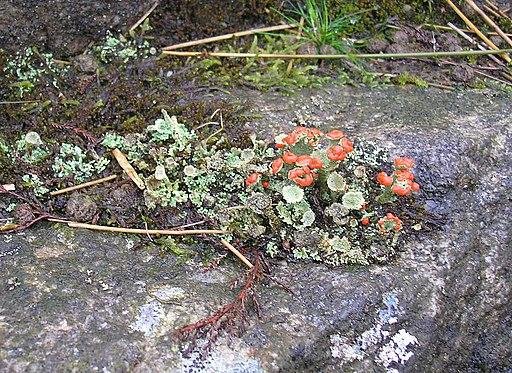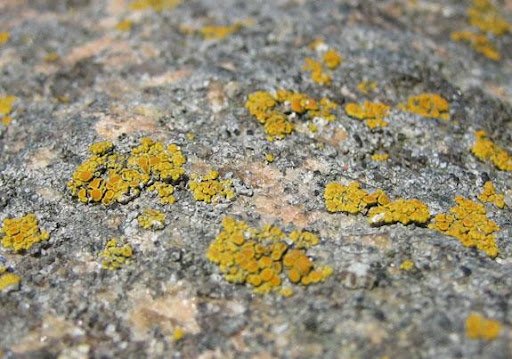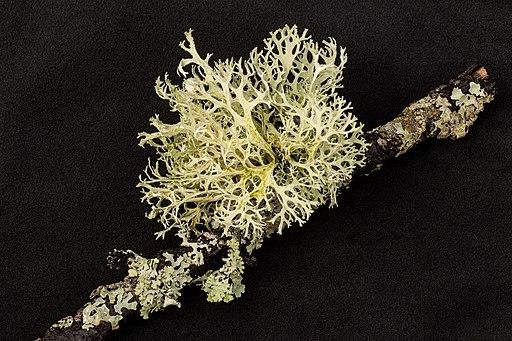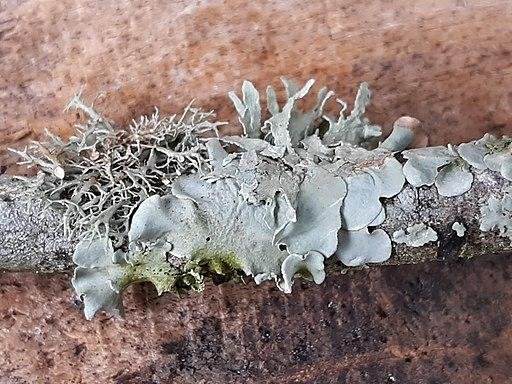By Misi Stine, Environmental Educator and member of the MN Herpetological Society
Lichens are fascinating, complex organisms that seem to be everywhere. They are found worldwide, from deserts to forests to tundra and many more habitat types. There are an estimated 20,000 species worldwide and approximately 3,600 species in North America. Lichens occur as the result of a symbiotic relationship between algae and fungus, and in some lichens, there are cyanobacteria that are part of the relationship.
The fungus is the builder, providing structural support and helping to retain water and nutrients. The algae provide food through photosynthesis. Algae can survive independently, but fungus cannot since they do not produce their own food. The cyanobacteria can photosynthesize and fix atmospheric nitrogen into nitrates, nitrites, and ammonia, allowing the fungus to absorb them.
Lichens evolved around the same time as terrestrial plants around 400 million years ago and today cover about eight percent of the planet's terrestrial surface. Their lifespan can be as short as 30 years or as long as 4,500 years. Lichens grow on a variety of substrates, including rocks, soil, or trees.
There are three growth forms of lichens. First are foliose lichens identified by their two sides, a top side, and a bottom side. They can appear flat, like a leaf or lettuce, but have ridges and bumps. Second is fruticose lichens which have a hair-like appearance and can be shrubby or cup-like. Fruticose lichens have a variety of branch-type structures that can range from round to flat in appearance. The flat branches can become tangled together. Some have a central core, and some are hollow in the middle. Finally, crustose lichens appear just like the name sounds; they form a crust over the substrate they occur on. They have a wide variety of colors that range from vivid and striking reds, oranges, and yellows to grays and greens. Crustose lichens can be found on various natural and manmade surfaces and appear to be pressed against the substrate.
Here are ten incredible facts about lichens:
Lichens can absorb just about everything in the air around them, including pollutants. As a result, studying lichens can provide us with essential environmental data. They can tell us about levels of toxins such as heavy metals and sulfur.
Lichens, when mixed with other substances like water and pine sap, or when burned, can be used to make dyes for clothing made from wool and other natural fibers and household items.
Lichens are food, shelter, and building materials for many species, including ungulates, birds, rodents, and insects.
Humans have also used lichens for food. One common genus found here, Bryoria, has been consumed as both a food needed for survival in lean times and also included in the everyday diet of Native American tribes throughout time. Some lichens were also provided to pets during lean times. Please be cautious, though. Some lichens are considered poisonous and are not safe to eat.
Some Native American tribes used wolf lichen for making poisoned arrowheads.
Some species of lichen are being researched to develop drugs because of their antibiotic properties.
If you look at the list of ingredients of personal care products, perfumes, and medical ointments, you may find lichens listed.
Lichens provide the means for algae to live in many different climates, where they alone could not survive; the algae can convert carbon dioxide to oxygen through photosynthesis which helps support life on Earth.
Lichens are decomposers breaking down rocks through the chemicals they release, to become soil. In the tundra, where there is not a large variety of plants to break down, lichens are essential for soil health.
Lichens are often overlooked or sometimes misidentified as moss, but mosses are nonvascular plants.
Interestingly, some scientists don’t agree that lichens are an organism but a small ecosystem containing a producer (algae and cyanobacteria) and a consumer (fungus). Like other unsettled science, finding the answer to this debate will take time. In the meantime, we can learn from and enjoy the variety of lichens the world has to offer.




Reference List
About Lichens. (n.d.). Retrieved from U.S. Forest Service: https://www.fs.usda.gov/wildflowers/beauty/lichens/about.shtml
al., K. e. (2012, March 26). Cyanobacteria produce a high variety of hepatotoxic peptides in lichen symbiosis. Retrieved from PNAS: https://www.pnas.org/doi/10.1073/pnas.1200279109#:~:text=Nostoc%20is%20by%20far%20the,absorbed%20by%20the%20fungal%20partner
Cate, S. (2019, November 9). Sciencing. Retrieved from Lichens that Live in the Tundra: https://sciencing.com/lichens-live-tundra-8261839.html
Ellis, M. (2017, November 3). KQED Inform. Inspire. Involve. Retrieved from KQED: https://www.kqed.org/perspectives/201601136599/lichens-three
Iowa State University. (n.d.). Getting to Know Us. Retrieved from Iowa State University: https://www.biology.iastate.edu/getting-know-us
Lichen Biology. (n.d.). Retrieved from US Forest Service: https://www.fs.usda.gov/wildflowers/beauty/lichens/biology.shtml#:~:text=There%20are%20three%20main%20types,Crustose
Lichens- Did You Know? (n.d.). Retrieved from U.S. Forest Service: https://www.fs.usda.gov/wildflowers/beauty/lichens/didyouknow.shtml#:~:text=Lichens%20have%20been%20used%20for,deer%2C%20birds%2C%20and%20insects
Waleski, Joe. Lichen of the North Woods. Canada: Kollath+Stensaas, 2007. Print.